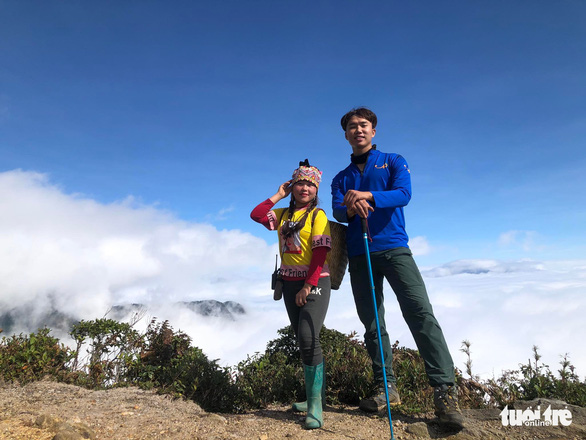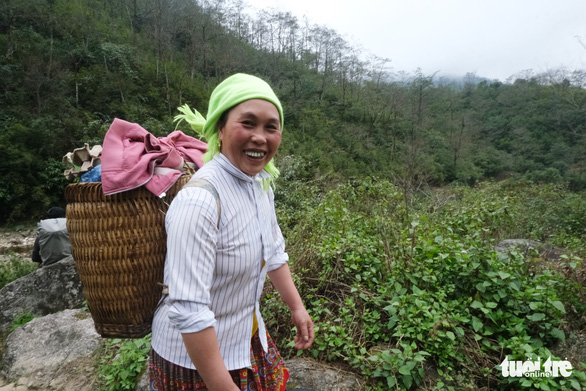Climbing is inherently hard, add nearly 20 kilograms of cargo and the faces of the porters turn red and begin to sweat in the bitterly cold weather.
On misty mountains, Mong women, from the eponymous ethnic minority living in Vietnam’s northern mountainous regions, follow their husbands to assist trekkers with conquering northwestern mountain peaks.
At 9:00 am, a car travels for over 60 kilometers from Sa Pa Town in northern Lao Cai Province, transporting tourists to an area in Sang Ma Sao Commune in the province’s Bat Xat District.
When the car arrives at the destination, two women quickly arrange food, clothing, and other necessities for the tourists and put them into their gui, a basket used by ethnic minorities in Vietnam.
Porters in the northwestern regions are mostly indigenous men who are of sturdy build and aged 18 to 40 on average.
But it would not be hard to realize that leading a trekking group one day is a female porter in a colorful Mong outfit who is enthusiastic about supporting trekkers.
Often leading groups of trekkers to conquer mountain peaks in the northwestern region, Bui Huy Khoi, a young tour guide, refers to Giang Thi Lien, a 27-year-old local girl in Sang Ma Sao Commune, with admiration in his voice: “Traveling with porters for a while, I think that female porters are really good at their job.
“Having trekked with Lien for three consecutive days earlier, I saw her rushing back to her farm work without taking a break right after completing the tour.”
Lien looks quite young for her age, with rosy cheeks impressing travelers throughout the trekking trip to conquer the Nhiu Co San peak, which is 2,965 meters above sea level.

Stopping by a rock, with a cheerful smile on her face, Lien says she was predestined to follow her husband to move to Ky Quan San Hamlet, and now she is again destined to earn her living as a porter along with her husband.
Earlier, A Chu and his wife mainly worked in the fields but still failed to make ends meet. He then discussed a plan to find travel-related jobs with his wife.
With vigorous health, A Chu and other men of Ky Quan San Hamlet decided to work as porters, accompanying trekkers to conquer great mountains.
Recognizing that the more A Chu climbs, the stronger his health becomes, and the more money he can earn, Lien, after giving birth to two children, decided to follow in her husband’s footsteps.
“I do the same job as my husband because I love to do so,” she says delightfully.
At the beginning, she only worked as her husband’s assistant.
After five years doing the job, Lien is now more confident and can serve as the main porter for each tour and provide guidelines for other female newbies.
“Climbing is not hard at all, just get used to it,” she says honestly.

The job of a porter is carrying travelers’ bags and other loads.
Depending on the number of travelers who book tours in groups or individuals, each porter will be in charge of carrying a restricted weight of some 25 kilograms, around 18-20 kilograms for female bearers.
As each trip of climbing mountains and walking through forests is quite long and adventurous, male carriers usually have the edge over their female peers.
During the trekking trip, despite not being able to speak Vietnamese fluently, Sung Thi Voi, 47, always encourages young trekkers to keep moving on.
Seeing any trekker tired, she is willing to carry extra cargo for them without complaining.
Each porter is currently paid VND400,000 (US$17.5) per day. For individual travelers, the fee could be a little bit lower depending on the number of tourists on that day.
This job offers them better income than farming jobs. Hard-working jobs do not bother upland women.
“This job is inherently for men, but we try to do the job to help them as much as we can," Lien says.
"The job also helps us become happier and learn more from travelers."
On the recent International Women’s Day on March 8, local women in northwestern Vietnam still received tour bookings from travelers.
All of them hoped that the COVID-19 pandemic could be soon brought under control so more tourists can book trekking tours.
This would the most amazing gift for female porters.
"Female porters are usually wives or family members of old male porters. They initially travel along with the male porters as their assistants and gradually become main sherpas. Further, travelers generally love to talk to and admire female porters as the latter have good health as well as even better climbing skills than their male peers," said Bui Huy Khoi.
Like us on Facebook or follow us on Twitter to get the latest news about Vietnam!

















































